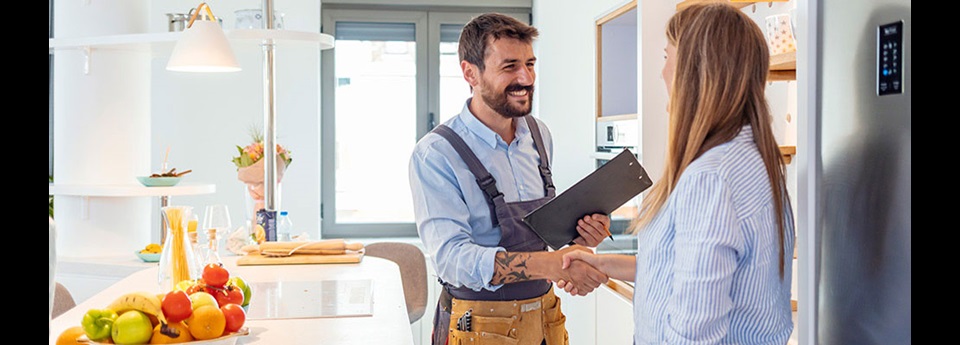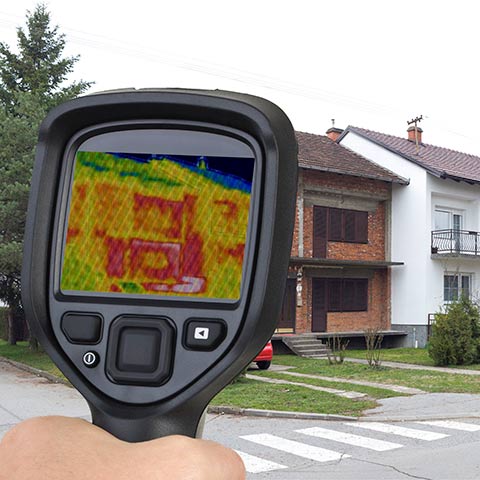
The Complete Guide to
Home Energy Assessments
Get a Detailed Plan to Save Money and Boost Comfort in Your Home
Uneven indoor temperatures. Drafty doors. Ice buildup on the roof. These are a few telltale signs that a home is operating inefficiently and wasting energy.
Completing an energy assessment, also known as an energy audit, is the first step to making your home more energy efficient and comfortable. Through the assessment, an energy auditor will provide an overview of your home’s energy use, pinpoint where it’s wasting energy, flag any safety or health issues, and identify energy-saving opportunities.
All New York homeowners and renters living in 1-4-family homes are eligible for a no-cost energy assessment. Other building types, such as businesses, multifamily buildings, and not-for-profit organizations may qualify for incentives and technical support to help cover the cost of an energy assessment.
Read on for our complete guide to home energy assessments and take control of your energy use.
When Should You Get a Home Energy Assessment?
If you’re experiencing high energy costs or drafty conditions in your home, getting an energy assessment can uncover the underlying causes and put you on the path to lasting energy savings and comfort.
Depending on how your home uses energy, getting ahead of higher heating costs in winter or increased air conditioning usage in summer could be opportune times for an energy assessment. It’s also important to get an assessment before making efficiency upgrades and installing clean energy technologies like solar or heat pumps to ensure the system is correctly sized. With a well-insulated and sealed home, you may be able to install a smaller system, another potential savings opportunity.
What Does a Home Energy Assessment Entail?
A home energy assessment is performed in-person by a professional energy auditor. It typically takes between a half hour to three hours to complete depending on the property size and if any testing is involved (more on that below). The assessment process can be thought of in three phases: evaluation, testing, and efficiency recommendations.

Thermal imaging with an infrared camera helps identify heat and energy loss.
Evaluation often begins with an analysis of a home’s historical energy use (i.e., utility bills) to establish a baseline for energy performance. Then, auditors conduct an inspection of the home’s interior and exterior to assess sources of energy loss and potential health and safety issues, such as mold or poor ventilation. They’ll typically examine the heating and cooling systems, insulation levels, doors and windows, lighting fixtures, and other structural components that make up the building envelope.
During a more in-depth assessment, an auditor may also run tests to measure airtightness in the building. A common method is a blower door test, which involves installing a fan in an exterior doorway to pull air out of the house, lowering the air pressure inside to help detect air leakage. Auditors may also run a thermographic scan with an infrared camera to home in on heat loss and leaks in the home.
Based on the results, auditors will compile a report with recommendations to make your home more energy efficient. Reports may also outline the estimated cost and expected annual savings for moving forward with upgrades, such as adding insulation or converting to heat pumps ![]() . Keep in mind that many potential energy upgrades identified in an assessment are eligible for Inflation Reduction Act tax credits and New York State incentives.
. Keep in mind that many potential energy upgrades identified in an assessment are eligible for Inflation Reduction Act tax credits and New York State incentives.
Implementing the recommended energy efficiency upgrades from an assessment typically cuts a home’s energy use by 5-30% [1].
Preparing for a Home Energy Assessment
Planning ahead can help make the most of an assessment. Compile a list of any existing problems in your home, such as drafty rooms or condensation, to raise with the energy auditor. It’s also helpful to have questions prepared for any improvements you’re interested in making, whether installing a heat pump water heater ![]() or home electric vehicle charging port.
or home electric vehicle charging port.
Having copies of a year’s worth or more of energy bills gives the auditor a better understanding of your home’s energy use and potential issues before completing the walkthrough inspection. Ensuring there’s easy access to the attic, basement, and HVAC equipment in the home beforehand is also recommended to streamline the process and ensure you’re getting a top-to-bottom home assessment.
Finding an Energy Auditor and Getting Started
Homeowners and renters have a few options depending on their income level and where they live. All New York homeowners or renters living in one-to-four family homes can contact a participating energy audit contractor to set up a no-cost energy assessment. Note that PSEG Long Island ![]() electric customers can schedule a free home assessment through their utility.
electric customers can schedule a free home assessment through their utility.
Through EmPower+, low- and moderate-income New Yorkers can get a no-cost energy assessment of their home, plus help finding contractors and navigating incentives. Participants are also eligible for discounts on energy efficiency improvements identified by the assessment, such as replacing inefficient refrigerators and air sealing to reduce drafts.
Homeowners installing “seal and insulate” packages through NYSERDA’s Comfort Home Pilot Program will also receive an assessment to inform energy-saving improvements, such as high-performance windows and insulation upgrades.
More on Home Energy Efficiency
Energy assessments are the first step in reducing a building’s energy use and carbon footprint. Dive deeper into energy-saving opportunities and creating healthier living spaces with the resources and stories below.
- Improve Your Home’s Indoor Air Quality: Discover ways that you can use clean energy to improve your indoor air quality and create a healthier home.
- NYS Guide to Inflation Reduction Act Savings: Find out how to combine IRA tax credits and New York State incentives to save on clean energy upgrades to your home, business, or vehicle.
- Regional Clean Energy Hubs: Get hands-on support navigating clean energy programs and opportunities from knowledgeable community-based organizations in your region.
- U.S. Heat Pump Sales Surpass Gas Furnaces: Learn why heat pumps are becoming increasingly popular in New York and how to make the switch to clean heating and cooling.
Footnotes
- Energy saver 101 infographic: Home Energy Audits. Energy.gov. (n.d.). https://www.energy.gov/energysaver/articles/energy-saver-101-infographic-home-energy-audits
 . Back to content
. Back to content
Sign Up For News
Stay up to date on energy-saving programs and incentives, best practices, and more.
Stay Connected
